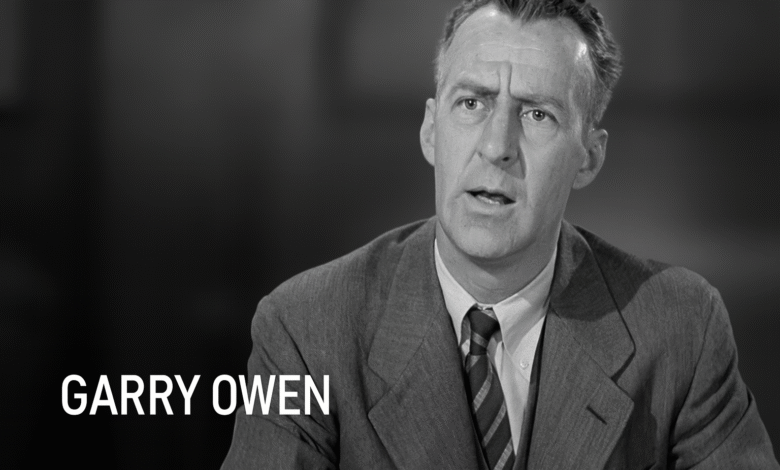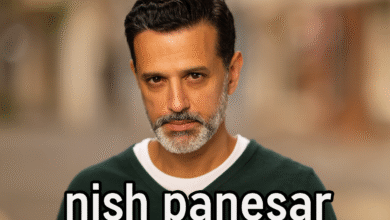Garry Owen: Hollywood’s Unsung Hero of Classic Cinema
Exploring the enduring legacy of a character actor who brought depth and realism to over 185 films.

Introduction
Garry Owen was one of Hollywood’s most prolific character actors during the golden era of cinema, known for his seamless performances in over 185 films. Though not a leading man, Owen had an undeniable presence that brought authenticity and charm to even the smallest roles. From taxi drivers to reporters, he portrayed everyday characters with a realism that resonated with audiences and added depth to countless classic films. His most iconic appearance, as the cab driver in Arsenic and Old Lace (1944), still earns recognition from classic film lovers today.
Born in Brookhaven, Mississippi, Owen made his way to Hollywood during the 1930s, quickly establishing himself as a dependable performer in an industry driven by stars and spectacle. Despite the lack of spotlight, his legacy lies in the way he supported cinematic storytelling from the background—making him an unsung hero of American film history
Quick Bio
| Full Name | Garry Owen |
|---|---|
| Date of Birth | February 18, 1902 |
| Place of Birth | Brookhaven, Mississippi, USA |
| Date of Death | June 1, 1951 |
| Place of Death | Hollywood, California, USA |
| Nationality | American |
| Profession | Film Actor |
| Active Years | 1933–1952 |
| Famous Role | Taxi Driver in Arsenic and Old Lace |
| Film Appearances | Over 185 |
Garry Owen was born on February 18, 1902, in Brookhaven, Mississippi. Growing up in the American South, Owen was part of a generation that witnessed the golden age of cinema unfold. While details about his family background and education are scarce, his move from a small-town upbringing to the heart of Hollywood reflected the classic American dream.
His early life likely shaped his work ethic and humble demeanor, traits that later became visible in the down-to-earth characters he frequently portrayed on screen. With a natural ability to blend into any scene, he would later become a familiar face in many classic films, even if his name remained unfamiliar to the average moviegoer.
The Start of a Prolific Acting Career
Owen’s film debut came in 1933, during a period when Hollywood was booming with creativity and expansion. He quickly made a name for himself as a reliable supporting actor, someone who could deliver exactly what a director needed in a short amount of screen time.
His consistent presence in film after film established him as a go-to choice for roles such as taxi drivers, reporters, clerks, and policemen. Although these were not lead roles, his performances brought credibility and nuance to the scenes he appeared in, which is why filmmakers kept inviting him back.
Standout Roles and Career Highlights
Perhaps the most iconic role of Garry Owen’s career was his portrayal of the taxi driver in Frank Capra’s Arsenic and Old Lace (1944). Though small, the role left a lasting impression due to Owen’s naturalistic acting and memorable presence. It’s a testament to how a well-executed minor role can stand the test of time.
Owen also appeared in classic films such as The Thin Man, It’s a Wonderful Life, Notorious, The Killers, and The Dark Mirror. His ability to adapt to both drama and comedy made him a flexible asset to many productions. Over the course of nearly two decades, he accumulated more than 185 film credits—an astonishing number by any standard.
Garry Owen’s Signature Style and Roles
One of Owen’s most distinctive traits as an actor was his ability to disappear into roles. He wasn’t a leading man, but rather a scene-enhancer—a character actor who made the story feel real. He often played ordinary working-class figures: the cab driver who gets caught in a mix-up, the bartender who overhears a secret, or the police officer asking the right questions at the wrong time.
This typecasting might have limited his exposure to leading roles, but it carved out a unique niche for him in the industry. Directors appreciated his efficiency, and audiences subconsciously trusted his familiar presence on screen.
The Final Years and Lasting Legacy
Garry Owen passed away on June 1, 1951, in Hollywood, California. His career ended shortly before the television era would change entertainment forever, making him a staple of the big screen’s golden age. Though his name is not widely remembered today, his face is instantly recognizable to classic film enthusiasts.
His work ethic and dedication continue to inspire aspiring character actors. In many ways, Owen represents the backbone of old Hollywood—the army of supporting players who brought life to background roles and helped elevate major stars with their grounded, convincing performances.
Why Garry Owen Still Matters Today
In a time when celebrity and leading roles dominate the conversation, Garry Owen’s story reminds us of the importance of the ensemble. He wasn’t a household name, but his presence added richness and authenticity to every film he touched.
Modern filmmakers and film historians still admire Owen for his immense body of work and his ability to bring realism into fiction. His career is a model for how consistency and professionalism can lead to a lasting legacy, even without top billing.
Frequently Asked Questions (FAQ)
Who was Garry Owen?
Garry Owen was a prolific American character actor active from 1933 to 1952, known for supporting roles in over 185 classic Hollywood films.
What is Garry Owen’s most famous role?
His most notable role was the taxi driver in Arsenic and Old Lace (1944), directed by Frank Capra.
When and where was he born?
He was born on February 18, 1902, in Brookhaven, Mississippi, USA.
When did Garry Owen die?
He died on June 1, 1951, in Hollywood, California, at the age of 49.
What kind of roles did Garry Owen typically play?
He often portrayed taxi drivers, policemen, reporters, and other working-class figures in supporting roles
Conclusion
Garry Owen may not have had top billing in Hollywood’s biggest films, but his legacy proves that every role—no matter how small—can be meaningful. With more than 185 screen appearances, he showcased an unmatched level of consistency, reliability, and skill that kept him working through two decades of evolving cinema. His portrayal of humble, relatable characters added depth and realism to stories that otherwise might have felt incomplete.
Today, Garry Owen is remembered not for fame but for impact. His contributions helped define the standard for what a great supporting actor could be. In celebrating his work, we honor the thousands of character actors who, like Owen, brought heart and humanity to the silver screen—one scene at a time



